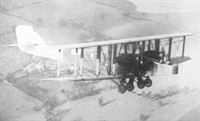Фотографии
-
Регистрационный номер: G-EBEP, D5799 This D.H.9, ex D5799, flew with Surrey Flying Services from late 1922. In November 1929 G-EBEP crashed at West Hill, Sanderstead, in Surrey, and was written off.
Самолёты на фотографии: De Havilland D.H.9 - Великобритания - 1917
-
Регистрационный номер: C9713 A rare photograph of Handley Page O/400 C9713 after modification to W/400 standard, with a new set of wings and new, clear-doped, tail of the type later to become standard on the W.8 airliner. Trials were carried out at Martlesham, Farnborough and Cricklewood, and C9713 was finally taken out of service in July 1920. This aircraft never bore a civil registration and remained the property of the Air Ministry, although it was on loan to Handley Page during the trials.
Самолёты на фотографии: Handley Page H.P.12 (O/400) - Великобритания - 1917
-
Регистрационный номер: G-EARI G-EARI was the prototype D.H.18, and flew with Aircraft Transport & Travel Ltd. for only a short period. On August 16, 1920, it crashed into some gardens in Wallington after experiencing engine trouble coming out of Croydon.
Самолёты на фотографии: De Havilland D.H.18 - Великобритания - 1920
-
Регистрационный номер: G-EBMW The prototype D.H.66 Hercules, G-EBMW, was first flown on September 30, 1926. Unlike the production batch the prototype featured an open pilot’s cockpit. 'MW was operated by Imperial Airways and was named City of Cairo. In April 1931 it left for the Far East on an experimental air mail flight, but on April 19 it ran short of fuel and was wrecked in the ensuing forced landing at Koepang.
Самолёты на фотографии: De Havilland Hercules / D.H.66 - Великобритания - 1926
-
Регистрационный номер: G-EBFC This photograph almost certainly depicts the first Napier Lion-powered Vickers 74 Vulcan, G-EBFC. This aircraft was delivered to Imperial Airways on December 23, 1924, although it was first flown on March 3 the previous year. 'FC was flown on continental services until December 1925 and was dismantled and burnt in 1927.
Самолёты на фотографии: Vickers Vulcan / Type 61 - Великобритания - 1922
-
Регистрационный номер: G-EAPY Designed originally as the D.H.14 day bomber, the Airco D.H.14A G-EAPY was completed by the Aircraft Manufacturing Co. Ltd., Hendon, as a long range two-seat mailplane for F. S. Cotton. On February 2, 1920, Cotton left Hendon in G-EAPY for the first flight from London to Cape Town, but a forced landing in Italy ended this flight and the aircraft was shipped back to England and rebuilt. A special four-wheel undercarriage had been fitted for the Cape flight, but this was replaced by a two-wheel unit for the aeroplane’s participation in the 1920 Aerial Derby on July 24. A forced landing at Hertford wrecked the aircraft and it was written off.
Самолёты на фотографии: De Havilland D.H.14 Okapi - Великобритания - 1919
-
Регистрационный номер: G-EBKI The one and only D.H.54 Highclere, G-EBKI was first flown on June 18, 1925, by Hubert Broad. After use by the Air Council ’KI was lent to Imperial Airways for evaluation but was never used. It was destroyed on February 1, 1927, when a hangar, heavily laden with snow, collapsed and crushed it to matchwood. The Highclere featured a jettisonable undercarriage for emergency ditching and camber-changing flaps.
Самолёты на фотографии: De Havilland Highclere / D.H.54 - Великобритания - 1925
Статьи
- -
- Bristol (Westland) Belvedere /Preservation Profile/ (56)
- News Spotlight
- Personal album
- Skywriters
- B.Gunston - Hamilcar Tank Carrying Glider
- B.Martin - Britain's civil aircraft register
- B.Service - Manu Rere
- D.Murray Peden - Salute to the Stirling (2)
- E.Morgan, C.Burnet - Spiteful
- G.Todd - Wings over the Irrawady
- L.Hendrix - An F-6 from the deep
- N.Parnell - Tinea Rarus
- P.Jarrett - A brevet before breakfast
- R.Riding - Miles M.1 Satyr /British pre-war ultralights/






